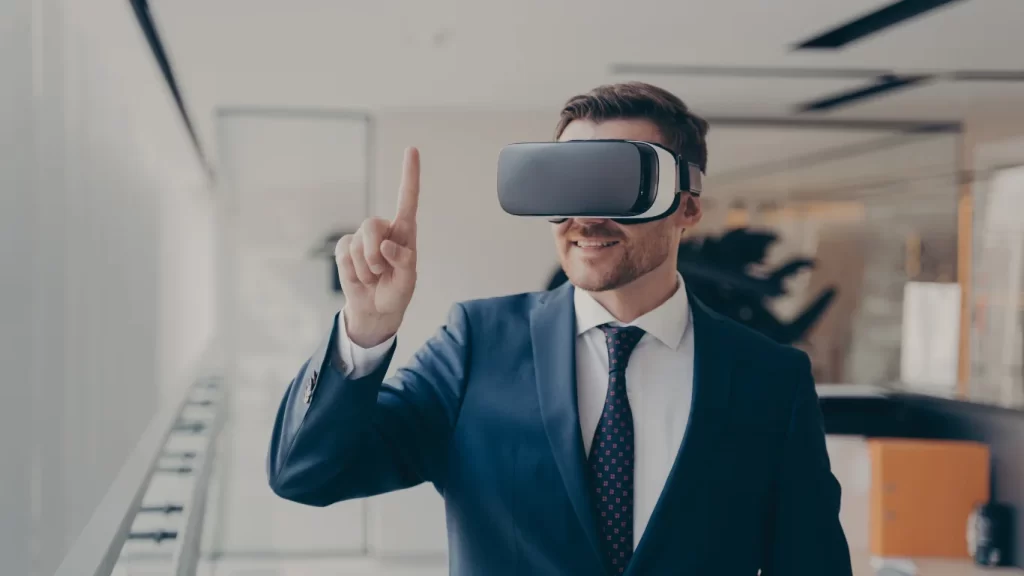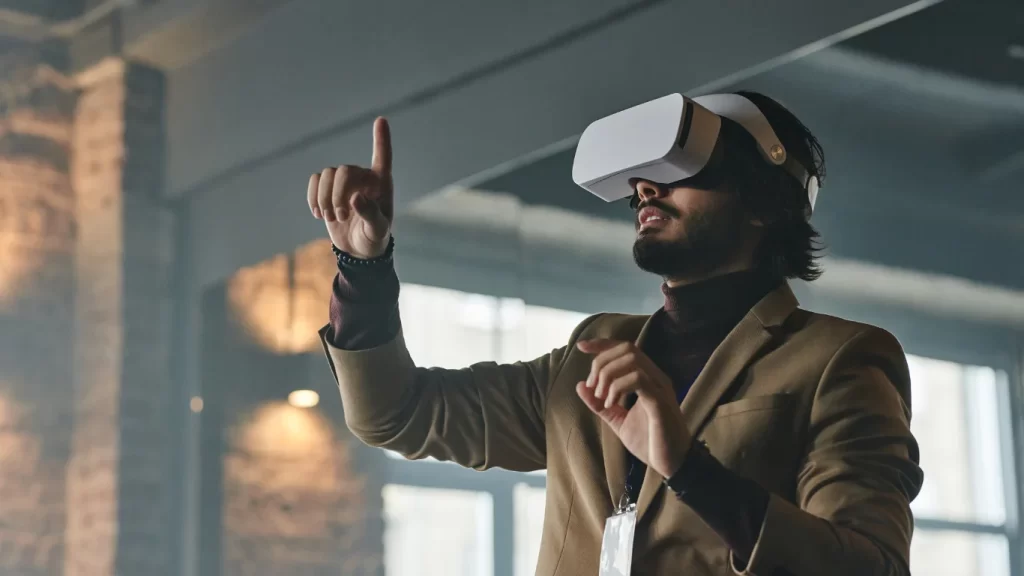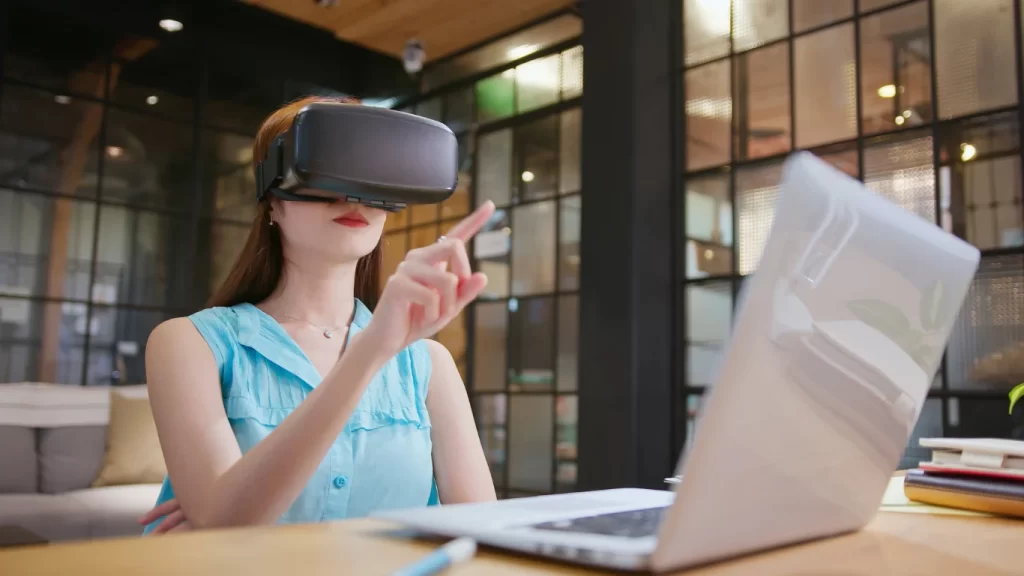Augmented reality and virtual reality are shifting the landscape of B2B marketing, presenting unprecedented opportunities for immersive branding and customer engagement. Augmented reality mixes digital content with the natural world to improve the user’s environment with virtual elements for interaction. Virtual reality allows users to explore digital worlds using headsets or goggles, providing a deep level of interaction.
These technologies, AR and VR in B2B campaigns, offer distinct advantages, including improved customer experiences and engaging marketing strategies. By using computer-generated images and simulated environments, marketers can create fun campaigns that connect with their audience. In B2B, businesses can use augmented reality (AR) and virtual reality (VR) to design immersive customer experiences that stand out in the digital era. This helps businesses to communicate effectively with their target audience.
Understanding Augmented Reality and VR in B2B Campaigns

Augmented Reality (AR) and VR in B2B campaigns are changing by merging digital content with the real world. This integration helps clients learn about products and services through interactive experiences in real time. These dynamic interactions make it easier for clients to make informed decisions. Critical aspects of AR in B2B marketing include:
- Interactive Product Demonstrations: AR technology enables prospects to visualize and interact with products in their real-world environment. Offering a ‘try before you buy’ experience helps customers gain confidence and trust in a brand. It also showcases the features and capabilities of products. This boosts the overall customer experience and can lead to increased sales.
- Enhanced Sales Presentations: With AR-enhanced dynamic sales presentation materials, pitches become more interactive, engaging, and persuasive. This not only retains audience interest but also facilitates a deeper connection with the product or service being offered.
- Augmented Training and Networking: AR provides immersive training experiences and rich environments for participants to interact, learn, and network. This is particularly beneficial in B2B settings where understanding complex products or services is crucial.
AR in B2B campaigns enhances brand identity and engagement by integrating digital content with the real world. AR in B2B campaigns improves brand identity and engagement by combining digital content with the physical world. This tech enables users to interact with virtual elements while remaining aware of their environment. It enhances presence at events and makes product demonstrations more interactive.
Exploring Virtual Reality’s Role in B2B Marketing
Studying how Virtual Reality (VR) is used in B2B marketing shows that immersive experiences are essential in creative campaigns. VR’s capability to create fully immersive digital environments allows businesses to transcend traditional marketing boundaries, offering unique and memorable experiences to their B2B clients. Critical aspects of VR in B2B marketing include:
- Virtual Product Tours and Trade Show Simulations: Companies are using virtual reality to create interactive tours of their products and services and simulate trade show experiences. This helps showcase their offerings and reach a wider audience without any geographical barriers.
- Customized Training and Remote Collaboration: VR and AR technologies foster enhanced learning outcomes through customized training programs and facilitate remote collaboration. This is very helpful for showing complicated products or when a deep understanding is needed. It’s a valuable tool for sales and tech support teams.
- Immersive Storytelling and Gaming: By employing VR, companies can tell captivating stories, transport their audience to different settings, and incorporate gaming elements. This not only strengthens emotional connections with the brand but also boosts customer engagement and loyalty. Furthermore, VR allows for the creation of virtual replicas of physical spaces, enhancing communication, collaboration, and innovation within B2B contexts.
Augmented Reality (AR) is tech that overlays digital content onto the natural world. It also allows users to interact with virtual elements while staying connected to their surroundings. In B2B campaigns, AR can be used to reinforce brand identity, maximize presence at events, and bring product demos to life.
AR apps are becoming more accessible and cost-effective, making it sensible to integrate this technology into B2B marketing strategies. By doing so, businesses can engage customers and prospects innovatively and effectively.
Critical Advantages of Integrating AR and VR into B2B Marketing

Using AR and VR in B2B marketing can improve engagement, simplify processes, and strengthen relationships between businesses and clients. Here are some key benefits:
1. Enhanced Engagement and Interaction
- Immersive Product Demonstrations: Allows potential clients to experience products in a realistic virtual environment, leading to a better understanding and excitement about the offerings.
- Interactive Content for Engaging Narratives: Using AR-powered content, like QR codes or AR markers, can provide additional information, videos or 3D models to enhance user engagement and experiences. This technology is designed to trigger the content simply and interactively.
2. Cost Efficiency and Data Insights
- Savings on Marketing and Sales Expenses: By avoiding the need for physical prototypes or samples, companies can significantly reduce costs.
- Data-Driven Insights and Analytics: AR and VR platforms provide valuable insights into user behaviours and preferences, enabling businesses to tailor their marketing strategies for improved outcomes.
3. Competitive Edge and Customer Confidence
- Competitive Advantage: Early adoption of AR and VR technologies can provide businesses with a significant edge over competitors who are yet to leverage these innovative tools.
- Increased Customer Confidence: Studies show that AR gives shoppers more confidence about product quality, and a majority prefer shopping with retailers that offer AR experiences, highlighting the importance of these technologies in building trust and encouraging purchases.
Addressing Implementation Challenges

AR and VR technologies have massive potential for B2B marketing, but using them can be challenging for businesses. They need to overcome obstacles to implement these technologies successfully. These challenges range from technical limitations to cost considerations and user adoption barriers. Addressing these effectively is crucial for leveraging AR and VR’s full potential in B2B campaigns.
- Cost and Resource Constraints:
- High Development Costs: Initial expenses for AR and VR technologies can be prohibitive, especially for smaller businesses. This includes costs for 3D model creation, hardware, and software.
- Expertise Shortage: There’s a lack of talent experienced in AR and VR development, which can hinder the creation and maintenance of these technologies.
- Technical and User Adoption Hurdles:
- Device Compatibility and Lighting Conditions: Technical limitations, such as compatibility with various devices and optimal lighting conditions, can affect the quality of AR experiences.
- Limited Content Availability: Not all businesses have the expertise or resources to create compelling AR content, which can limit the Technology’s effectiveness.
- User Experience: Ensuring that AR and VR experiences are seamless, intuitive, and accessible, including for users with disabilities, is paramount.
- Strategies for Overcoming Challenges:
- Integration with Physical Environments: Ensuring virtual objects are well integrated with physical surroundings enhances the user experience.
- Use of Lighting, Shadows, and Sound: Strategic use of these elements can create more convincing and engaging AR experiences.
- Simplifying Technology: AR/VR technology should be made simple for those not accustomed to new media, addressing resistance to change and promoting wider adoption.
Businesses can succeed in AR and VR marketing by planning strategically and using innovative solutions to engage their B2B audience. This involves addressing challenges effectively. Captivating the B2B audience is critical to creating successful campaigns.
Innovative Use Cases of AR and VR in B2B Marketing

In B2B marketing, using AR and VR tech creates new ways to engage and provide immersive experiences for customers. Highlighting a few pioneering examples:
Training and Safety Simulations:
- Lloyd’s Register has developed a virtual reality safety simulator. This simulator is a crucial tool for training workers in the energy industry to navigate catastrophic scenarios safely.
- SIMBOTT makes VR and AR technology more practical for industrial training. It covers essential skills such as welding, painting, aircraft maintenance, and driving.
Product Demonstrations and Virtual Showrooms:
- Ottobock leverages AR to unveil the intricate mechanics of its prosthetic limbs, enriching customer understanding and engagement.
- Key Technology offers a virtual reality experience to customers, allowing them to see how a sorting machine operates. This immersive demonstration highlights the potential of VR to showcase products.
Interactive Catalogs and Marketing Tools:
- Cisco has created an interactive virtual reality product catalogue, which is like a virtual trade show. This allows people to explore the products in great detail.
- Adobe’s Aero & #ProjectPronto simplifies the creation of AR campaign content, showcasing the potential for dynamic and interactive marketing strategies.
These examples demonstrate how AR and VR can change B2B marketing by providing new ways to interact, teach, and attract customers.
Conclusion
When it comes to actually using augmented reality and virtual reality in B2B marketing, businesses can create innovative and engaging ways to connect with their clients. This shift represents an excellent opportunity for businesses to improve their marketing strategy. Different audiences have different needs, and businesses should consider their target audience when writing the text.
Companies can now use virtual trade shows, interactive content, and immersive product demonstrations to create experiences that enhance customer understanding and engagement. Augmented and virtual reality can change how businesses interact with customers.
They provide engaging experiences that help build brand loyalty. This encourages customers to explore products and services more. The examples and insights discussed highlight how AR and VR can help businesses create meaningful connections with their clientele.
When businesses consider the uses of AR and VR, it’s essential to implement these technologies strategically. To fully benefit from their potential, businesses will need to overcome technical and cost barriers.
To connect well with business customers, companies should prioritize making AR and VR technology user-friendly for better experiences. This can massively help companies stand out from their competitors and create stronger relationships with their clients and customers. Success in B2B marketing comes from using new technology to create meaningful customer experiences, leading to business success.
FAQs
How are AR and VR utilized in marketing strategies?
AR and VR can create entertaining games and experiences that draw in potential customers. These technologies also enable customers to engage with the brand in a more fun and interactive manner. Such gamified experiences can increase user involvement, cultivate brand loyalty, and double as entertainment, leading to extended brand engagement. You can also use AI to boost it as well.
In what ways is virtual reality shifting the marketing field?
Virtual reality introduces immersive storytelling to marketing, allowing brands to create engaging stories in which users become active participants. Moving from watching to participating creates stronger emotions and a lasting impression on the audience.
What makes augmented an attractive tool for marketers?
Augmented reality offers marketers the ability to design interactive and engaging experiences tailored to consumer interests and behaviours. Focusing on customer experiences helps engage and convert customers, making it attractive to marketers looking to drive results.
How are AR and VR reshaping the gaming industry?
AR and VR have changed gaming by adding new levels of interaction and immersion that were not possible before. These technologies have the power to enhance storytelling and social interactions within games, offering players more engaging and realistic experiences.





